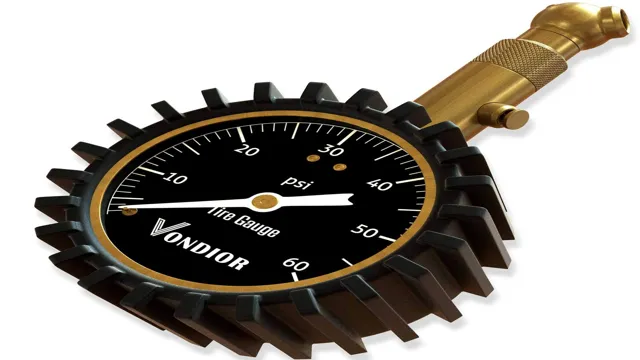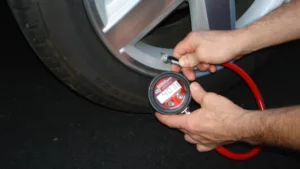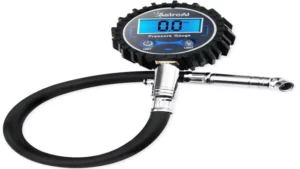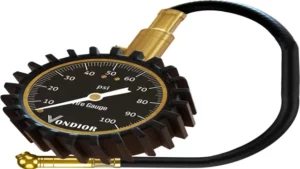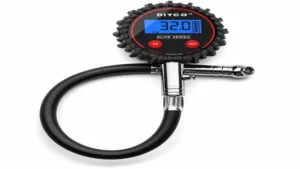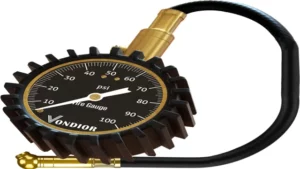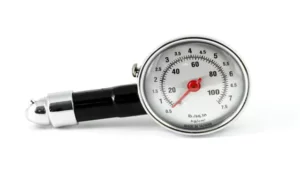Maintaining proper tire pressure is crucial for the safety and longevity of your vehicle. Not only does it affect the handling and performance of your car, but it can also impact fuel efficiency and tire wear. However, checking your tire pressure doesn’t have to be a daunting task.
By using a tire pressure gauge correctly, you can easily ensure that your tires are inflated to the recommended levels. In this blog, we’ll go over the steps on how to use a tire pressure gauge, so you can feel confident in your ability to take care of your vehicle. So, grab your gauge and let’s get started!
Step 1: Determine the Correct Pressure
Properly using a tire pressure gauge is important for maintaining the longevity and safety of your vehicle. The first step is to determine the correct pressure for your tires, which can be found in your owner’s manual or on the label inside the driver’s door. Once you know the correct pressure, you can use your gauge to check the current pressure of your tires.
Make sure that your tires are cold before checking the pressure, as heat from driving can cause the pressure to increase. Insert the gauge into the valve stem and press down firmly to get a reading. If the pressure is too low, use a pump to inflate the tire to the correct pressure.
If the pressure is too high, use the gauge to release some air. Always double-check the pressure after making any adjustments. By properly using a tire pressure gauge, you can ensure that your tires are at the correct pressure and increase your vehicle’s fuel economy, handling, and overall safety on the road.
Check the vehicle owner’s manual or the sticker on the driver’s side door for recommended pressure.
The first step in ensuring proper tire pressure is to determine the correct pressure for your vehicle. It’s essential to check the vehicle owner’s manual or the sticker located on the driver’s side door for recommended pressure. Often, the recommended pressure may also vary depending on the type of tires you have installed.
The optimal tire pressure is based on the manufacturer’s specifications, and it ensures optimal driving performance, fuel efficiency, and tire durability. Driving on tires with low pressure can cause premature wear, reduce fuel economy, and affect handling. Overinflated tires, on the other hand, can make the ride rough and lead to uneven wear or even tire blowouts.
Therefore, it’s crucial to ensure that your tires are inflated to the recommended pressure for your safety and the vehicle’s longevity.
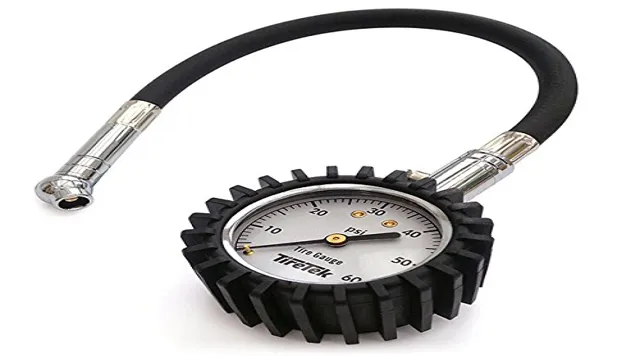
Step 2: Unscrew the Cap
Now that you’ve located the tire pressure gauge and know how to zero it out, it’s time to unscrew the cap on your tire. This step is crucial, as it allows you to actually access the valve stem and measure the pressure inside the tire. Make sure to check for any debris or dirt that might have accumulated on the valve stem, as this can throw off your reading.
Once the cap is off, you can begin to take your reading with the gauge. Press the gauge firmly onto the valve stem and wait for the meter to stabilize before recording the PSI. Remember, accurate tire pressure is key to prolonging the life of your tires, and can also improve fuel efficiency.
So take your time and ensure each tire has the correct pressure. By following these steps, you’ll be able to confidently use a tire pressure gauge and keep your vehicle rolling smoothly.
Unscrew the valve cap from the tire valve stem.
Unscrewing the valve cap is the second step in inflating your tire. It may seem like an easy task, but don’t underestimate its importance. The valve cap’s purpose is to protect the valve stem from dirt, debris, and moisture, which can cause the valve to malfunction.
It also maintains the tire’s air pressure by preventing air from escaping. To unscrew the cap, locate the valve stem on your tire, which is usually located close to the rim. The valve stem is a small, protruding metal or rubber tube that allows you to inflate your tire.
Once you’ve located it, take hold of the valve cap and twist it counter-clockwise until it comes off. Be careful not to drop the cap, as it can be easy to lose. Remember to keep the valve cap in a secure location while you inflate your tire and replace it when you’ve finished inflating to protect your valve stem.
Step 3: Press the Gauge onto the Valve Stem
Now that you have properly aligned the gauge with the valve stem, it’s time to press the gauge onto the stem. Be sure to apply enough pressure to create a tight seal, but not too much that it causes damage to the valve. Once you hear a hissing sound, stop pressing it, and check the gauge reading.
Do this three times to ensure accuracy and consistency. Remember, it’s essential to use the correct technique when using a tire pressure gauge to prevent any mishaps. Using a gauge regularly ensures that your tires are well-maintained, which could save you from any unwanted accidents and prolong the life of your tires.
So, don’t hesitate to check your tire pressure monthly or whenever necessary to keep your ride safe and enjoyable.
Press the gauge firmly onto the valve stem until you hear a hiss sound.
When it comes to checking your tire pressure, it’s important to make sure you’re getting an accurate reading. That’s why it’s essential that you press the gauge firmly onto the valve stem until you hear a hiss sound. By doing this, you’re ensuring that the gauge is creating a tight seal with the valve stem, which is where the air pressure measurement is taken from.
But why is this important? If there’s a leak or a gap between the gauge and the valve stem, it could lead to an inaccurate reading and could result in under or over-inflating your tires. This could cause a host of problems, including decreased fuel efficiency, reduced handling and stability, and even tire blowouts. So, take the time to press the gauge down firmly, and you’ll be sure to get an accurate reading and keep your tires in top condition.
Step 4: Read the Gauge
Once you have attached the tire pressure gauge properly, it’s time to read the gauge. First, make sure the gauge is in the “off” position before placing it on the valve stem. Firmly press the gauge onto the stem and wait for the reading to stabilize.
The pressure reading will be displayed on the gauge’s dial, typically in PSI (pounds per square inch). If the reading is lower than the recommended pressure for your vehicle, use an air compressor to add air until it reaches the ideal pressure. On the other hand, if the reading is higher than recommended, release some air by pressing the gauge onto the stem until the desired pressure is reached.
It’s crucial to verify the correct pressure range for your vehicle, which can typically be found in the owner’s manual or on a sticker in the driver’s side door jamb. Remember, maintaining proper tire pressure is essential for safety and fuel efficiency.
The gauge will display the current pressure of the tire.
Now that you have attached the pressure gauge to the tire valve stem, it’s time to read the display. The gauge provides a precise measurement of the current pressure within the tire. It’s essential to read the gauge accurately to ensure that the tire is inflated to the correct pressure.
Most gauges have a simple interface that displays the current pressure in either PSI (pounds per square inch) or BAR (kilograms per square centimeter). Make sure to read the gauge with the valve stem positioned on the top to get an accurate reading. If the tire pressure is too low, add some air until it reaches the recommended level.
If the tire pressure is too high, release some air until it’s adjusted to the right level. Remember, keeping your tires inflated to the correct pressure will improve your vehicle’s performance, safety, and fuel efficiency. So, make it a habit of checking your tire pressure regularly, and you’ll avoid any unexpected troubles on the road.
Step 5: Compare with Recommended Pressure
Once you have successfully measured the air pressure in your tires using a tire pressure gauge, it is important to compare the reading with the recommended pressure for your vehicle. This information can typically be found on a sticker located inside the driver’s door or in the owner’s manual. If the reading is less than the recommended pressure, you will need to add air to your tires until you reach the correct pressure.
On the other hand, if the reading is higher than the recommended pressure, you will need to release some air from your tires until you reach the correct pressure. It is important to maintain the correct tire pressure for your vehicle as it can help improve fuel efficiency, extend the life of your tires, and provide a safer driving experience. Remember to check your tire pressure regularly, especially before a long road trip, to ensure optimal performance of your vehicle.
With these simple steps on how to properly use a tire pressure gauge, you can maintain your tires for optimal driving.
Compare the reading on the gauge with the recommended pressure for your vehicle. If the pressure is low, inflate the tire as necessary.
After you’ve connected the air hose to the tire valve stem, it’s time to get a reading on the tire’s pressure. This is where the tire pressure gauge comes in handy. Take a look at the reading on the gauge and compare it to the recommended pressure for your particular vehicle.
It’s important to note that different vehicles have different recommended pressures, so make sure you’re checking for the right amount. If the reading on the gauge indicates that the pressure is low, you’ll need to inflate the tire as necessary. This is crucial for maintaining proper vehicle safety and performance.
Don’t ignore a low pressure reading as it can contribute to tire wear and even affect your fuel efficiency. And remember, checking your tire pressure regularly is a simple task that can easily be incorporated into your overall vehicle maintenance routine.
Step 6: Repeat for All Tires and Replace Valve Caps
Now that you’ve successfully checked the tire pressure of one tire, it’s time to repeat the process for all your tires. Remember to check the pressure of your spare tire as well. Once you’ve checked all the tires, make sure to replace each valve cap.
It may seem like a small detail, but valve caps help to prevent dirt and debris from clogging the valve and causing air leakage. Additionally, valve caps help to maintain the proper pressure in your tires by preventing the air from escaping. By taking the time to repeat these steps on all four tires and replacing the valve caps, you’ll help to ensure that your vehicle is safe and ready for whatever the road may bring.
Remember, using a tire pressure gauge is a straightforward process that can help prevent dangerous driving conditions and save you from potential tire damage that could lead to costly repairs.
Repeat steps 2-5 for each tire and replace valve caps when finished.
After successfully completing the first tire check, it’s essential to repeat the steps for each of the remaining tires. This ensures that all your tires are at the same level of pressure, which prevents the car from being unbalanced when driving. As you move on to check the next tire, repeat steps 2-5, starting by removing the valve cap, using the tire pressure gauge to take the reading, and inflating or deflating the tire as needed.
It’s crucial to ensure that you check all tires, including the spare tire, as this guarantees that you don’t get stranded on the side of the road with a flat tire. Once you finish checking each tire, replace the valve caps, making sure they are secure enough not to fall off during driving. Checking the pressure in all the tires shouldn’t take much time, and it’s a simple and effortless way to ensure that your car performs well on the road.
Don’t forget to check your tires regularly to keep them in good shape and avoid unnecessary tire wear and tear.
Additional Tips for Proper Tire Maintenance
When it comes to maintaining your tires, one key step is to regularly check the tire pressure using a tire pressure gauge. But how do you properly use one? First, make sure the gauge is the right type for your tires – it should be calibrated in psi (pounds per square inch) and match the recommended pressure for your vehicle. Next, remove the valve cap from the tire and press the gauge onto the valve stem firmly and straight.
Wait for the gauge to give a reading, and then compare it to the recommended pressure – if it’s too high or too low, adjust accordingly. Finally, don’t forget to replace the valve cap and repeat the process for all four tires. By maintaining proper tire pressure, you’ll not only extend the life of your tires, but also improve your vehicle’s overall performance and safety on the road.
Regularly check tire pressure and condition, rotate tires every 5,000-7,000 miles, and replace tires when necessary.
Proper tire maintenance is crucial for the safety and longevity of your vehicle. Apart from checking pressure and condition and rotating the tires every 5,000-7,000 miles, there are a few additional steps you can take to ensure your tires remain in top shape. Firstly, avoid overloading your car beyond its weight limit, as this can cause the tires to wear out quickly.
Additionally, keep an eye out for uneven tread wear, which could indicate an alignment or suspension issue. When driving, avoid sudden stops or sharp turns, as this can cause excessive wear and tear on the tires. Finally, consider investing in quality tires, as they tend to last longer and provide better performance.
By following these tips, you can ensure your tires remain in excellent condition, enabling you to enjoy a smooth, safe, and comfortable driving experience. So take good care of your tires, and they’ll take care of you!
Conclusion
In summary, using a tire pressure gauge is like taking your car’s blood pressure – essential for maintaining optimal health! Just like our bodies, our vehicles need proper care and attention to perform at their best. So, don’t be a flat tire, use a pressure gauge regularly to ensure your vehicle’s tires are always pumped up and ready to hit the road. Plus, don’t forget to brag about your impressive pressure checking skills to your friends, they’ll be blown away!”
FAQs
What is a tire pressure gauge and why is it important to use one?
A tire pressure gauge is a tool used to measure the amount of air pressure in a tire. It is important to use one regularly as proper tire pressure helps improve gas mileage, increases tire lifespan, and enhances overall driving safety.
How do I use a tire pressure gauge properly?
To use a tire pressure gauge properly, remove the valve cap from the tire, press the gauge onto the valve stem to get a reading, and compare the reading to the recommended tire pressure found in your vehicle owner’s manual or on the tire itself. Make sure to check tire pressure when the tires are cold for the most accurate reading.
What are the common types of tire pressure gauges?
The most common types of tire pressure gauges include digital gauges, pencil gauges, and dial gauges. Each type has its own benefits and drawbacks, so consider your specific needs and preferences before choosing a gauge to use.
How often should I check my tire pressure?
It is recommended to check your tire pressure at least once a month and before long road trips. Changes in temperature can also cause tire pressure to fluctuate, so it’s especially important to check during extreme weather conditions.
Can I use any tire pressure gauge on my tires?
Yes, as long as the gauge is compatible with the valve stem on your tires, you can use any type of tire pressure gauge. Just be sure to read the instructions carefully to ensure proper use.
What should I do if my tire pressure reading is low?
If your tire pressure reading is low, add air to the tire until it reaches the recommended pressure. Be sure to check the tire again after a few hours of driving to ensure the pressure is still correct.
Can I rely on my car’s Tire Pressure Monitoring System (TPMS) instead of using a gauge?
While TPMS can alert you when tire pressure is low, it’s still important to use a tire pressure gauge regularly for the most accurate readings. TPMS can sometimes give false readings, and it’s also important to note that not all cars come equipped with a TPMS.
